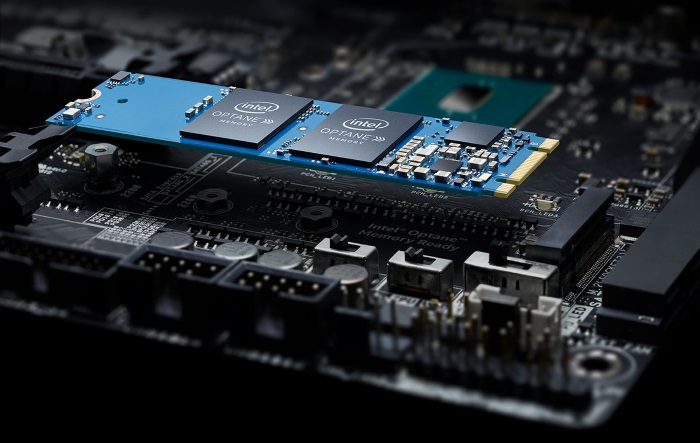
By Brian Santo, contributing writer
Like a miser reluctantly counting out coins he does not wish to spend but must, Intel finally introduces its first 3D Xpoint products based the 3D Xpoint technology that it’s been touting for years as the next big innovation in computer memory — a pair of solid state drives (SSDs): the Optane SSD DC P4800X, an enterprise-level 375GB PCIe card, and a consumer-level product with the brand name “Optane Memory.” The latter comes in two variants: a 16GB SSD listed at $44 and a 32GB drive for $77. Both are add-in modules for PCs built around 7th Generation Intel Core microprocessors.
Because Intel is still perfecting the manufacturing process, however, the SSDs are underwhelming in terms of storage capacity. Consequently, the company had to invent a niche application for them.
Disappointment with these first two products will almost certainly be a temporary problem. If production techniques are improved as expected, subsequent products will become increasingly dense. If so, 3D Xpoint will begin to fulfill its promise as a replacement for the types of memory that currently dominate the market.
The vast majority of the computer memory market is served by magnetic memory in the form of hard disk drives (HDDs) and two semiconductor memories — DRAM and NAND (aka flash).
HDDs are pretty cheap, and magnetic memory is nonvolatile — it persists in the absence of a power source. Fetching data from an HDD is a relatively slow process, though. That combination of qualities makes HDDs good for long-term storage and for data that is needed only occasionally. HDDs are vulnerable to competition because they’re bulky and, being mechanical systems, they are virtually guaranteed to eventually fail catastrophically. Worse, it’s getting increasingly more difficult to increase storage density, which has maxed out at a few terabytes.
DRAM and NAND have different characteristics that make them suitable for different sets of applications.
DRAM is volatile, fast (low-latency), and cheap, but it may become vulnerable to some competitive alternative because storage capacity (density) isn’t increasing from one product generation to the next fast enough anymore — DRAM development is no longer conforming to Moore’s Law, as the company notes in a video.
NAND memory is dense and nonvolatile, but not as fast as DRAM (high-latency), and a bit pricier, so NAND is rarely a suitable replacement for DRAM. SSDs based on NAND tend to get used when it’s important to have nonvolatile memory and HDDs are too slow. Some data centers are replacing HDDs with NAND-based SSDs, but, for now, usually only when money is no object. The latest “hard drives” with tens of terabytes are actually NAND SSDs.
Intel and Micron developed 3D Xpoint to get the best of both worlds — fast, dense, nonvolatile, and relatively inexpensive.
Intel has been saying all along that 3D XPoint will be roughly 1,000 times faster than NAND, with 1,000-times-higher write endurance. Compared to DRAM, 3D XPoint memory is supposed to be about 10 times denser. In a presentation last August, Intel said that it tested Optane against its own NAND, and Optane was 10 times faster on reads, had three times the endurance, four-times-greater performance on write IOPS (input/output operations per second), and drew 30% less power.
Should 3D Xpoint eventually achieve far greater densities than DRAM as expected, it should eventually start replacing DRAM in the highest-density applications and then take over more of the DRAM market from there. 3D Xpoint is faster than NAND and might start replacing NAND in some applications; for example, in hard drives.
The new Optane modules are far, far too small to replace HDDs or NAND-based SSDs, for that matter. PCs already have gigabytes worth of DRAM; if anyone really needed a few gigabytes more, they can have it.
So Intel engineers had to figure out what a small 3D Xpoint-based SDD might be useful for, and determined that the faster access could be exploited for launching PC apps faster than they would from a hard drive. Perhaps that sounds achingly pedestrian, but maybe that’s because we’ve become inured to irritating load delays.
“No one likes to wait,” wrote Navin Shenoy, senior vice president and general manager for the Client Computing Group (CCG) at Intel, in a recent blog post prepping the market for the introduction of Optane.
Intel says that web browsers will launch up to five times faster from Optane than from a hard disk drive, while other common apps will load a bit faster than that. Games and game levels will load around 67% faster. The company said that the modules have intelligent software that will learn users’ computing behaviors and adjust to make other actions faster, smoother, and easier.
To make 3D Xpoint memories, Intel builds storage elements, then slices them into a phalanx of smaller storage elements. It then connects the storage elements top and bottom with crossbars — viewed from above, they look like a cross-hatch. These phalanxes are stacked; hence, the name.
The storage elements apparently do not operate the same way that capacitors do in DRAM; the operative characteristic is resistance, not charge. It’s impossible to say exactly how it works because Intel steadfastly refuses to identify any of the materials that it is using, other than to intimate that it’s not silicon — or not just silicon — and that 3D Xpoint is not based on memristors. The slicing of the storage elements is likely to be an etch process, though Intel is deliberately opaque on that, too.
The company does say that 3D Xpoint can be made denser than DRAM because, unlike DRAM, 3D Xpoint storage elements do not need to have a transistor each. Instead, each storage element can be reached individually via the cross-hatch to be read or written.
Advertisement
Learn more about Electronic Products Magazine





